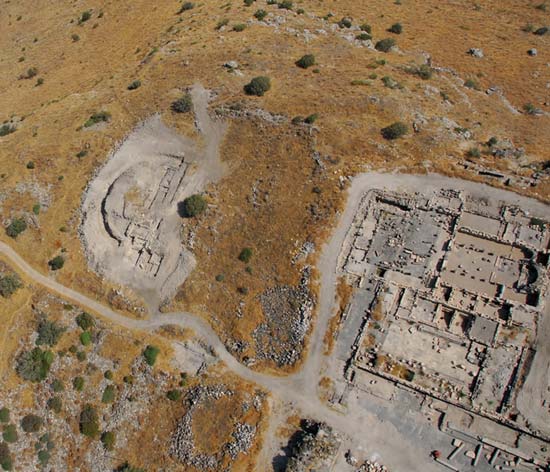Ancient Aphrodite Figures Hint at Pagan Resistance

Three figurines of Aphrodite, the ancient Greek goddess of love, have been found buried underground in the remains of a shop in a Roman city built in the second century B.C.
The hidden figures hint at the reluctance of some denizens of the Roman Empire to give up their pagan beliefs despite the spread of Christianity.
The ancient treasure, buried for more than 1,500 years, was uncovered during the tenth season of excavations that are being carried out by researchers of the Zinman Institute of Archaeology at the University of Haifa.
The hidden statues were discovered when the researchers exposed a shop in the southeastern corner of the forum district of Sussita, which is the central area of the mountaintop Roman city that existed through the Roman and Byzantine periods and destroyed in the great earthquake of 749 A.D. Sussita, also known as Hippos, is located in Israel and sits on a hill overlooking the Sea of Galilee. The city was originally built by Greek colonists, but later came under Roman rule.
The researchers say it was clear the followers had wished to hide the figurines, as they were found complete.
"It is possible that during the fourth century A.D., when Christianity was gradually becoming the governing religion in the Roman Empire, there were still a number of inhabitants in Sussita who remained loyal to the goddess of love and therefore wished to hide and preserve these items," said Arthur Segal, one of the excavation's leaders.
The clay pieces are 9 inches (23 cm) tall and represent the common model of the goddess of love known to the experts as Venus pudica, "the modest Venus." This name was given to the form due to its upright stature and the figure's covering her private parts with the palm of her hand. (Venus is the Roman name for the goddess of love. The term 'aphrodisiac' comes from the Greek name of the goddess.)
Sign up for the Live Science daily newsletter now
Get the world’s most fascinating discoveries delivered straight to your inbox.
Other finds
Another fascinating finding was an odeion – a small, roofed theater-like structure, the first of its kind to be exposed in Israel. Structures such as these were quite common in the Roman era and were intended for poetry-reading performances and musical recitals, the researchers said.
The excavation is still in its early stages, but the researchers have already been able to expose the entire perimeter of the odeion, which forms a rectangular area, at one end of which is a semi-circle. According to the researchers, the construction is of high quality and it seems that it can be dated back to the first century B.C. or A.D.
Also found in the excavations was a basilica, a roofed structure that would have been used as a substitute location for public gatherings in rainy weather. This is the second basilica to be exposed in Israel, the first being the Roman basilica of Samaria.
One of the basilica's columns has even been restored. "Just the look of the restored columns is enough to get an impression of the beauty and tremendousness of Roman architecture during that period," Segal said.
Ancient daily life
Archaeologists also exposed a living quarter, likely dating back to the fourth century. The finding gives a rare glimpse into the day-to-day lives of the inhabitants of Sussita during the last three centuries of the city's existence.
The excavation also shows that there were similarities between pagan and Jewish cities of the time.
At the close of the tenth season of excavations, we have revealed a abundance of public structures in the city, most likely associated with the reign of Herod in the first century B.C. Until now we have assumed that the wave of construction that took place during Herod's reign was primarily in Jewish cities, but the findings at Sussita are evidence of the king's influence on pagan cities under his rule too," the researchers concluded.
The project was supported in part by the Israel Nature and Natural Parks Protection Authority.
- Video – King Herod's Tomb Unearthed
- Top 10 Ancient Capitals
- Top 10 Aphrodisiacs










